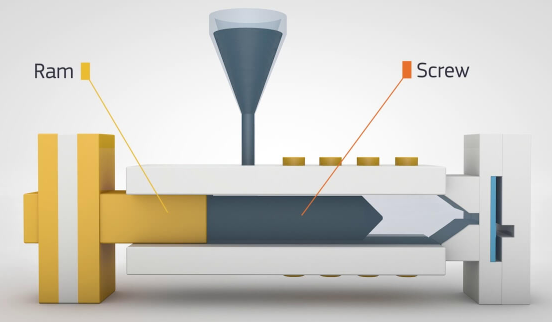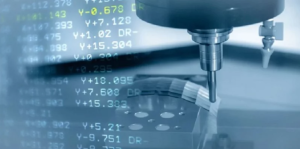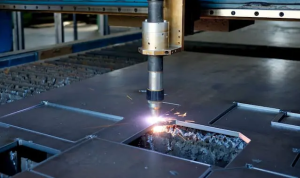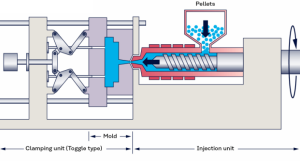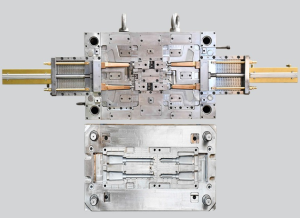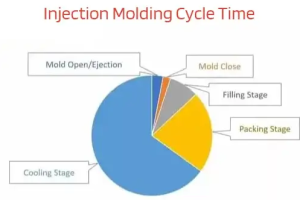Injection molding machines are critical in manufacturing plastic parts with precision and efficiency. Here’s a detailed explanation of how an injection molding machine works:
Components of an Injection Molding Machine
- Injection Unit:
- Hopper: Holds and feeds the plastic pellets into the barrel.
- Barrel: Heats and melts the plastic pellets.
- Screw: Rotates and moves the molten plastic forward. It also helps in mixing and heating the plastic.
- Heaters: External heaters that help melt the plastic as it moves through the barrel.
- Nozzle: Directs the molten plastic into the mold.
- Clamping Unit:
- Mold: Consists of two halves – the core and cavity. The mold shapes the final part.
- Clamping Mechanism: Opens and closes the mold. It holds the mold halves together during injection.
- Ejector System: Removes the finished part from the mold.
- Control System:
- Manages and monitors the entire injection molding process, including temperature, pressure, and cycle time.

Choose us for your custom injection molding needs and experience excellence in every detail. Our China-based factory provides innovative solutions, competitive pricing, and fast turnaround times. Get your custom quote now!
Injection Molding Process
- Clamping:
- The mold, consisting of two halves (core and cavity), is mounted on the clamping unit. The clamping unit closes the mold and ensures it stays closed under pressure.
- Injection:
- Plastic pellets are fed from the hopper into the barrel. The screw rotates and moves the pellets forward.
- Heaters around the barrel melt the plastic pellets as they move through.
- The molten plastic accumulates at the front of the screw. Once enough plastic has melted, the screw moves forward, injecting the molten plastic through the nozzle into the mold cavity.
- Cooling:
- The molten plastic in the mold cavity begins to cool and solidify, taking the shape of the mold.
- Cooling channels within the mold circulate a coolant (usually water) to speed up the cooling process.
- Ejection:
- Once the part has cooled and solidified, the mold opens.
- The ejector system pushes the finished part out of the mold.
- The mold then closes, ready for the next cycle.
Detailed Steps in the Injection Molding Cycle
- Plasticizing:
- The screw rotates, feeding plastic pellets from the hopper into the barrel.
- As the screw rotates, it moves the pellets forward, where they are heated and melted.
- Injection:
- The screw stops rotating and moves linearly, acting as a plunger to push the molten plastic into the mold cavity.
- High pressure ensures the plastic fills all the mold details.
- Packing:
- After the initial injection, additional molten plastic is packed into the mold to compensate for shrinkage as the plastic cools.
- The packing phase ensures that the final part has no voids and maintains dimensional accuracy.
- Cooling:
- The cooling time depends on the thickness of the part and the cooling system efficiency.
- Proper cooling is crucial to ensure the part solidifies uniformly and does not warp or deform.
- Mold Opening:
- Once the part is sufficiently cooled, the clamping unit opens the mold.
- Ejection:
- The ejector system activates, pushing the finished part out of the mold.
- Some molds use ejector pins, while others may use air blasts or stripper plates.

As a leading mold injection manufacturer in China, we deliver superior molds for various industries. Our state-of-the-art facilities and expert team ensure top-notch quality and timely delivery. Contact us now for a competitive quote!
Considerations for Efficient Injection Molding
- Material Selection:
- Different plastics have varying melting points, flow characteristics, and cooling rates. Choosing the right material for the application is critical.
- Mold Design:
- The design of the mold affects the quality and efficiency of the production process. Proper venting, gating, and cooling channel design are essential.
- Machine Settings:
- Optimizing temperature, pressure, injection speed, and cooling time is necessary to produce high-quality parts consistently.
- Maintenance:
- Regular maintenance of the machine and mold ensures consistent production quality and extends the life of the equipment.
Conclusion
Injection molding machines work by melting plastic pellets, injecting the molten plastic into a mold, and then cooling and ejecting the finished part. The process is highly efficient for producing large volumes of complex plastic parts with high precision. Understanding the components and the detailed steps of the injection molding cycle is crucial for optimizing production and ensuring the quality of the molded parts.
Related Conten: Plastic Blow Molding

